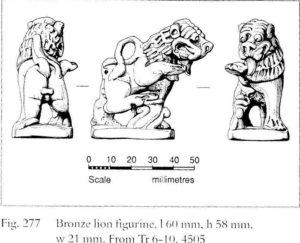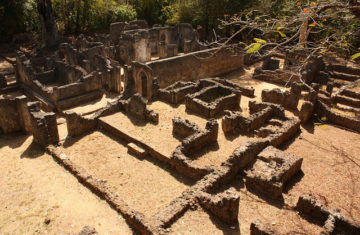Part 1 of our Swahili Coast articles mainly discussed the role of Arab and Persian merchants in East African commerce. But the Indian Ocean was an integrated whole, with extensive trade among all peoples on the coasts. Objects from India appear in the archaeological record from as early as the 7th century AD, and trade colonies of Indian merchants are well-attested by the year 1000. Archaeological finds in both East Africa and India demonstrate that both raw materials and finished products were traded across the Indian Ocean between those two lands. But what of the subtler commerce in ideas and artistic styles? And what of the exchange of people, who brought those ideas with them?

A paper on Indian-East African trade discusses precisely those questions. The problem is demonstrated with a bronze figurine depicting a lion, which was discovered in the major Swahili town of Shanga. The figurine was characteristic of Indian production techniques, and is artistically similar to many such objects used in Hindu ritual. The details of the work, however, reveal that it depicts an African, not an Asian, lion. A reasonable interpretation is that there were Indian craftsmen present in Shanga, who practiced their traditional trade using locally-available models.
So far, so good. But the Shanga lion was a singular object, of doubtlessly high value, of which no similar examples survive. What of more common objects?
The authors examine several categories of objects, such as beads, coins, and pottery, which were produced in both India and Africa. These were frequently traded between the two regions, and there seems to have been some mutual stylistic influence as well. But this mutual influence makes it impossible to determine how such objects were produced. They could have been: produced by local craftsman, who were influenced by foreign goods; produced by foreign craftsmen resident in Africa; or produced abroad by craftsmen influenced by African styles.
Archaeology has a much easier time with objects that were straightforwardly produced in one region and shipped to another. Clear signs of origin shed a bright beam of light on specific trade patterns, which draw scholars like moths. Much can be learned by studying them, like the latest possible date contact between two areas was established, or the intensity of trade along certain lines.
But much is left out from this line of inquiry. The study of mutual influence, by contrast, raises many questions that we would otherwise hardly think to consider. How exactly did Indian and Swahili craftsmen influence one another? Did native craftsmen apprentice in foreign workshops, and vice-versa? Or did they simply imitate the fruits of foreign workshops? Did mutual influence occur by some other means altogether?

In later ages, the thorough records left by merchants might clear up such mysteries. Unlike chroniclers or geographers, who only noted what was valuable and exotic in various lands, merchants were intensely practical. Their chief concern was noting the quantity, quality, and value of what they purchased, as well as who they purchased it from. Even fragmentary records could reveal how the network of workshops, markets, and trade lanes worked. But no such records survive from the golden age of the Swahili Coast. Whether merchants even kept them is unknown, and in any case irrelevant to our discussion—a gaping hole remains.
The authors of the paper suggest lines of research that could turn up clues. Carbon dating provides a rough timeline of when certain styles appeared, and isotope analysis reveals the origin of the raw materials. Together, these could provide a tantalizing glimpse at the evolution of this reciprocal exchange.
Answers to these inaccessible questions would reveal much about how society was structured in the busy ports of East Africa. Historians can only guess at the status of foreign merchant colonies relative to the ruling princes, the native populations, and other foreigners; any indication of their rights or restrictions would be telling. While the balance of power certainly varied over time—the history of the Swahili Coast was nothing if not volatile—even a few snapshots would reveal much new.
The trade networks centered on the stone towns of East Africa were singular examples in the pre-modern era of a mercantile society that concentrated people and wares from thousands of miles away. It is commonplace to describe such cosmopolitan emporia as swirls of spice and color, where cultures from far-flung lands blended into a distinctive style. But humans are fundamentally tribal, and expend great energy maintaining their group identity. Beneath the urbane veneer of great cities, groups have always jockeyed for privileges and status—the written histories of the Swahili Coast occasionally let slip the mask of such rivalries when they broke out in open conflict. But it is anyone’s guess what more can be learned from evidence out there waiting to be discovered.
Want to Learn More? Read:
A History of the East African Coast: Covers the history of the Swahili Coast from pre-history up to modern times.
A Splendid Exchange: How Trade Shaped the World: A history of trade throughout the world, with a special emphasis on the trade system that developed between Africa and India.


